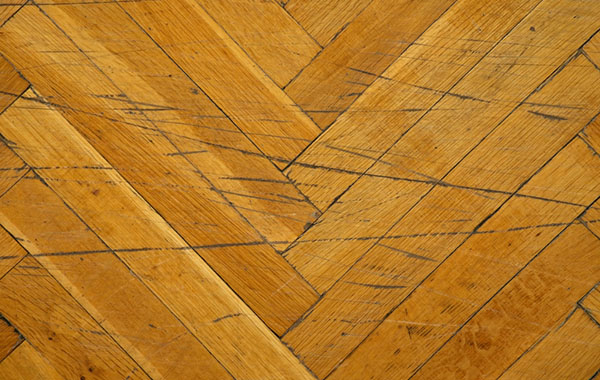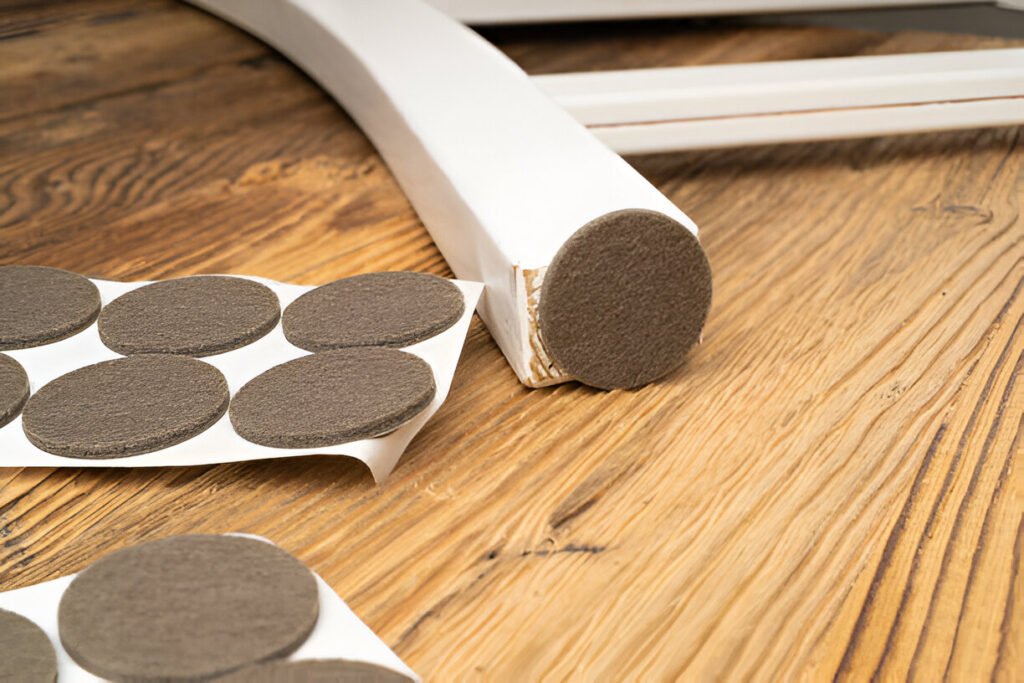Furniture pads can effectively prevent scratches on hardwood floors. They are easy to install and protect your flooring investment.
Hardwood floors add elegance and value to any home. Protecting them from damage is crucial for maintaining their beauty. Furniture pads are a simple yet effective solution to avoid scratches and scuffs. These pads come in various materials like felt, rubber, and plastic, each offering different levels of protection.
By placing them under the legs of your furniture, you can prevent direct contact with the floor. This not only preserves the finish but also extends the life of your flooring. Furniture pads are affordable, easy to apply, and can save you from costly repairs or refinishing in the long run.

Credit: www.ebay.com
Choose The Right Furniture Pads
Protecting your hardwood floors is crucial. One easy way is by using furniture pads. They act as a buffer between your furniture and the floor. This prevents scratches and damage. But, choosing the right pads is essential. Let’s dive into how to select the best ones.
Types Of Furniture Pads
There are different types of furniture pads available. Here are some common ones:
- Felt Pads: Soft and easy to apply, ideal for light furniture.
- Rubber Pads: Provide grip and prevent sliding, perfect for heavier items.
- Plastic Pads: Durable and long-lasting, suitable for all furniture types.
- Adhesive Pads: Stick to the furniture legs, ensuring they stay in place.
- Nail-on Pads: Secure and sturdy, ideal for permanent protection.
Material Considerations
Choosing the right material for your furniture pads is vital. Here are some factors to consider:
| Material | Pros | Cons |
|---|---|---|
| Felt | Soft, easy to apply, and gentle on floors | Wear out quickly |
| Rubber | Non-slip, sturdy, and provides good grip | May leave marks on some floors |
| Plastic | Durable, long-lasting, and versatile | Can be noisy on hard floors |
Choose the material that best suits your needs. For light furniture, felt pads work well. For heavy items, rubber pads provide better support. Always check the compatibility with your floor type. This ensures maximum protection and longevity.

Credit: twentyandoak.com
Proper Installation Of Furniture Pads
Protecting your hardwood floors from scratches is important. One effective method is using furniture pads. Proper installation of furniture pads ensures they stay in place and provide maximum protection. Follow these simple steps for a flawless installation.
Cleaning The Surface
Before attaching furniture pads, clean the surface of the furniture legs. Dirt and debris can prevent pads from sticking properly. Use a damp cloth to wipe away dust and grime. Allow the legs to dry completely before moving on to the next step.
Securing The Pads
Once the surface is clean, it’s time to secure the pads. Peel off the backing of the adhesive pads. Carefully align each pad with the bottom of the furniture leg. Press firmly to ensure a strong bond. Repeat this process for all legs of the furniture.
Regular Maintenance
Keeping your hardwood floors scratch-free is not difficult. Regular maintenance is key. Using furniture pads helps. Let’s explore some easy tricks.
Inspecting The Pads
Inspect furniture pads every month. Look for wear and tear. Worn pads can scratch your floors. Use a flashlight to see better. Check under heavy furniture first. Light items can wait.
| Furniture Type | Inspection Frequency |
|---|---|
| Heavy Furniture | Every Month |
| Light Furniture | Every Two Months |
Replacing Worn Pads
Replace worn pads immediately. Delays can cause scratches. Make a list of needed replacements. Choose pads that match your furniture legs. Use adhesive pads for easy application. Screw-on pads are best for heavy furniture.
- Remove old pads carefully.
- Clean the furniture legs.
- Attach new pads securely.
Proper pad replacement keeps floors safe. Inspect and replace pads regularly.
Additional Protective Measures
Protecting your hardwood floors from scratches is essential. Furniture pads are great, but they aren’t the only solution. Here are some additional protective measures you can take to keep your floors looking pristine.
Using Area Rugs
Area rugs are a fantastic way to shield your floors. Place them in high-traffic areas. They absorb shocks and prevent scratches. Choose rugs with a non-slip backing. This helps them stay in place.
Consider a rug pad for extra protection. It adds an extra layer between the floor and the rug. This prevents dirt and grit from causing damage.
Rearranging Furniture
Rearrange your furniture regularly. This distributes weight evenly across your floor. Heavy furniture left in one spot can cause dents and scratches.
Use felt pads under furniture legs. These make it easier to slide pieces without scratching the floor.
| Furniture | Suggested Frequency of Rearrangement |
|---|---|
| Sofas | Every 3-4 months |
| Chairs | Every 2-3 months |
| Tables | Every 6 months |
Also, consider using furniture sliders. They make moving heavy items easier. This reduces the risk of scratches.
Diy Furniture Pad Solutions
Protecting your hardwood floors from scratches doesn’t have to be expensive. DIY furniture pad solutions are an easy and cost-effective way to shield your floors. Let’s explore some homemade alternatives and cost-effective tips.
Homemade Alternatives
Homemade furniture pads are simple to create. They require common household items. Here are some ideas to get you started:
- Old Socks: Cut pieces from old socks. Attach them to the furniture legs.
- Felt Scraps: Use leftover felt from crafts. Secure them with glue or tape.
- Carpet Remnants: Use small carpet pieces. Glue them under furniture legs.
These materials are soft. They provide a protective layer. They prevent scratches on your floors.
Cost-effective Tips
Making your furniture pads can save money. Here are some cost-effective tips:
- Buy in Bulk: Purchase felt or foam in bulk. This reduces the cost per piece.
- Use Recycled Materials: Repurpose old clothes or carpets.
- DIY Adhesive: Use double-sided tape. It’s cheaper than buying pre-made pads.
Here’s a table of common household items and their uses:
| Item | Use |
|---|---|
| Old Socks | Cut into pieces for furniture legs |
| Felt Scraps | Attach with glue or tape |
| Carpet Remnants | Glue under furniture legs |
These tips are easy. They help keep your floors scratch-free. DIY solutions are both practical and budget-friendly.
Safety Considerations
Using furniture pads on your hardwood floors is not only about preventing scratches. It’s also about ensuring safety in your home. Let’s look at some important safety considerations.
Avoiding Slip Hazards
Furniture pads should grip the floor properly to prevent slipping. If pads slide, they can cause accidents.
Choose pads made from materials that have a strong grip. Rubber and felt pads are good options.
Regularly check your furniture pads. Replace any that show wear or lose their grip.
| Material | Grip Strength |
|---|---|
| Rubber | High |
| Felt | Moderate |
Ensuring Stability
Stability is another key factor. Furniture pads should not cause furniture to wobble.
Check that all legs of your furniture have pads. This keeps the furniture balanced.
If the furniture still wobbles, try adjusting the pads. Use thicker pads for uneven legs.
- Check all legs have pads.
- Use thicker pads for uneven legs.
- Test the stability after placing pads.
Following these safety tips ensures your home is both scratch-free and safe.

Credit: www.amazon.com
Frequently Asked Questions
How Do I Keep My Furniture From Scratching My Hardwood Floors?
Use furniture pads or felt protectors on legs. Keep floors clean from dirt and debris. Avoid dragging furniture. Use area rugs under heavy pieces. Regularly check and replace worn pads.
How To Keep Hardwood Floors From Getting Scratched?
Use furniture pads on all legs. Keep floors clean from dirt and debris. Trim pet nails regularly. Avoid high heels indoors. Use rugs in high-traffic areas.
How Can I Make My Hardwood Floors More Scratch Resistant?
Use rugs or mats to protect high-traffic areas. Trim pet nails regularly. Apply a high-quality finish. Use furniture pads. Keep floors clean and free of debris.
How Do I Stop My Recliner From Scratching The Floor?
Use furniture pads or felt glides under the recliner legs. Place a rug or mat beneath the recliner. Regularly clean the floor to remove debris.
Conclusion
Protecting your hardwood floors from scratches is simple with furniture pads. These easy tricks offer effective solutions. By applying these methods, you can maintain the beauty of your floors. Invest in quality pads and follow these tips for lasting results.
Your hardwood floors will thank you with their lasting shine.





